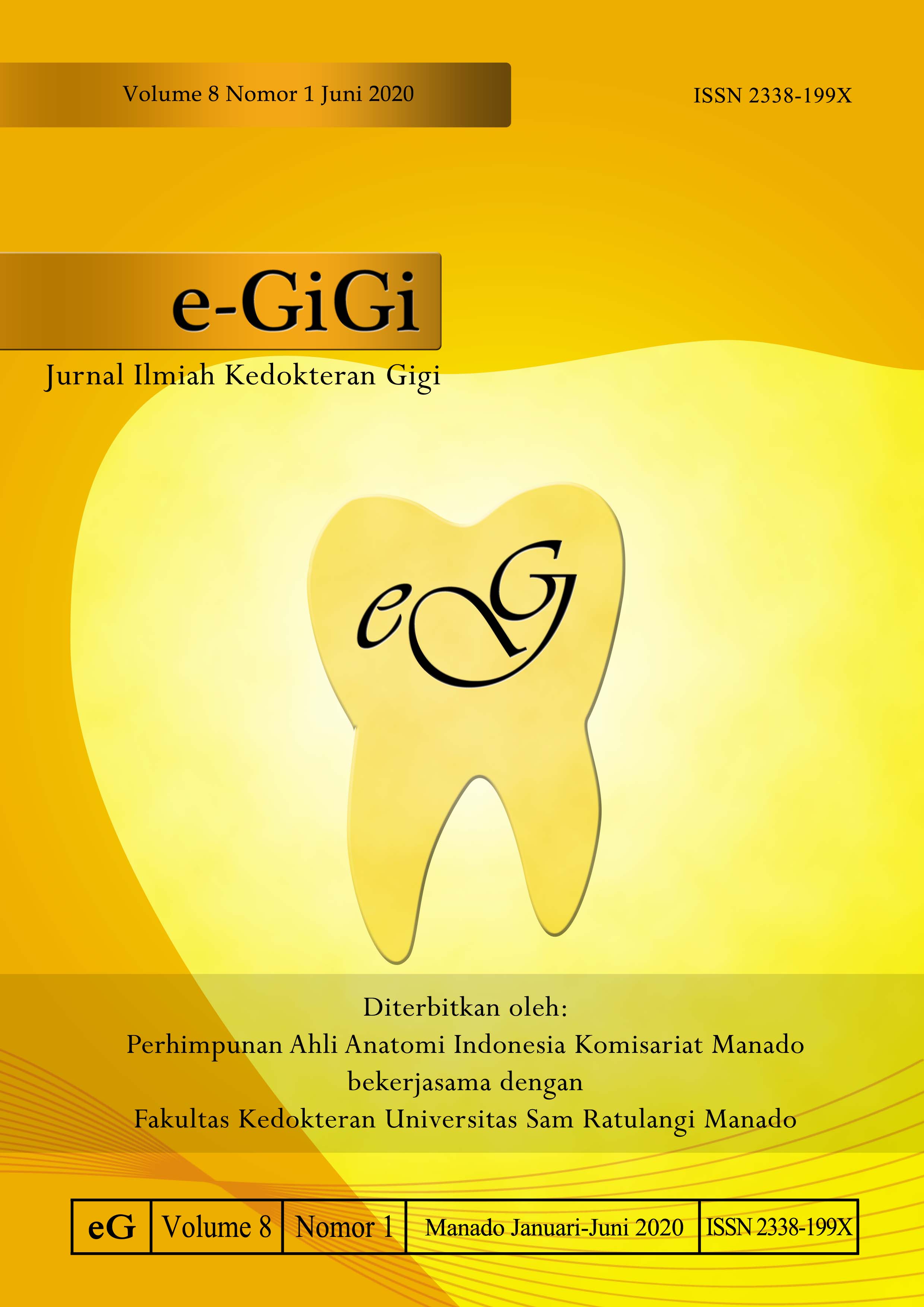Evaluasi Ekstraksi Molar Ketiga Rahang Bawah Berdasarkan Angulasi Mesial pada Radiografi Panoramik
DOI:
https://doi.org/10.35790/eg.8.1.2020.28743Abstract
Abstract: Third molar development is a concern in dental care because of its influence on stomatognathic system. Due to third molar irregular pattern of eruption, different clinical and radiographic considerations on how to decide an extraction were studied. This study was aimed to evaluate the effect of mandibular third molar mesial angulation (MA) towards the extractions on panoramic radiographs. This was a retrospective study. A longitudinal study of mandibular third molars (n=192) of 102 individuals (50 Female and 52 Male) was conducted. Development of the mandibular third molar was staged according to modified Köhler et al. staging technique. Mesial angulation was measured from the intersection between axes of third molar and adjacent second molar of the most developed stage for extraction cases or before root completion for non-extraction cases. Of 102 subjects, 107 mandibular third molars were extracted. The increase of 1° of MA would increase the odds ratio (OR) of extraction by 1.113 (95% CI 1.070-1.158, p<0.01). The ROC curve showed the MA of 18.5o as the threshold of extraction with 76% of sensitivity and 68% of specificity. In conclusion, MA has the possibility as a predictive factor of mandibular third molar extraction. Future studies using bigger sample sizes and variations of third molar development are suggested
Keywords: third molar, angulation, extraction, predictive factor, panoramic radiographs
Â
Abstrak: Pertumbuhan molar ketiga menjadi perhatian pada perawatan dental karena pengaruh-nya pada sistem stomatognasi. Terdapat banyak penelitian tentang berbagai pertimbangan klinis dan radiografis untuk melakukan ekstraksi molar ketiga karena pola erupsinya yang tidak menentu. Penelitian ini bertujuan untuk mengevaluasi efek angulasi mesial (AM) dari molar ketiga rahang bawah terhadap tindakan ekstraksi pada radiografi panoramik. Jenis penelitian ialah retrospektif. Pengamatan molar ketiga rahang bawah (n=192) secara longitudinal dilakukan pada 102 individu (50 perempuan dan 52 laki-laki). Pertumbuhan molar ketiga diukur berdasarkan tahap pertumbuhan dari teknik modifikasi Köhler et al. AM diukur dari pertemuan aksis molar ketiga dan molar kedua di sebelahnya, pada tahap pertumbuhan paling akhir pada kasus ekstraksi, atau sebelum akar gigi terbentuk sempurna pada kasus non-ekstraksi. Pada sampel penelitian, ekstraksi dilakukan pada 104 molar ketiga rahang bawah. Peningkatan 1o dari AM akan meningkatkan rasio peluang dari ekstraksi sebesar 1,113 (95% CI 1,070-1,158, p<0,01). Pada kurva ROC, AM sebesar 18,5o menunjukan 76% sensitivitas dan 68% spesifisitas. Simpulan penelitian ini ialah AM dapat digunakan sebagai faktor prediksi terhadap ekstraksi molar ketiga rahang bawah. Perkembangan penelitian selajutnya dapat dilakukan dengan jumlah sampel yang lebih besar dan dengan memperhatikan pertimbahan klinis serta parameter radiografik lainnya.
Kata kunci: molar ketiga, angulasi, ekstraksi, faktor prediksi, radiografi panoramik
Downloads
How to Cite
Issue
Section
License
COPYRIGHT
Authors who publish with this journal agree to the following terms:
Authors hold their copyright and grant this journal the privilege of first publication, with the work simultaneously licensed under a Creative Commons Attribution License that permits others to impart the work with an acknowledgment of the work's origin and initial publication by this journal.
Authors can enter into separate or additional contractual arrangements for the non-exclusive distribution of the journal's published version of the work (for example, post it to an institutional repository or publish it in a book), with an acknowledgment of its underlying publication in this journal.
Authors are permitted and encouraged to post their work online (for example, in institutional repositories or on their website) as it can lead to productive exchanges, as well as earlier and greater citation of the published work (See The Effect of Open Access).






